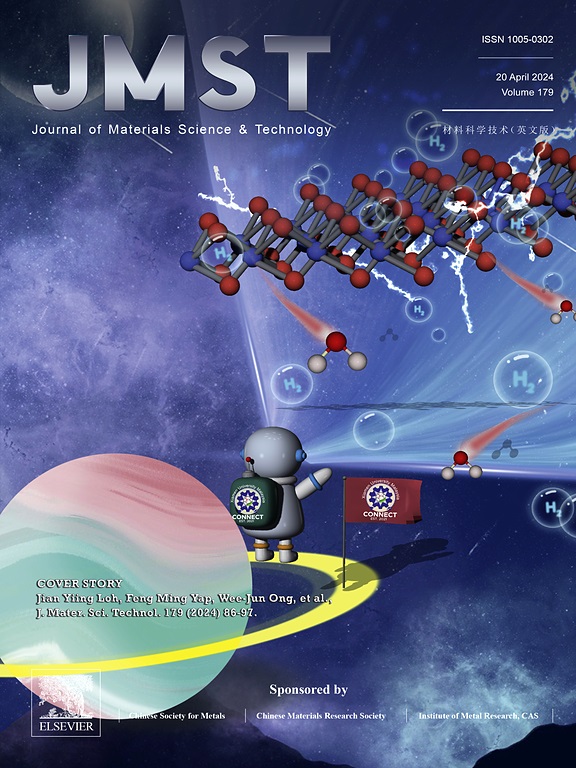Metal chelate-derived and catalytical strategy to produce CoFe/C@bamboo-like carbon nanotubes for microwave absorption, hydrophobicity, and corrosion resistance
IF 11.2
1区 材料科学
Q1 MATERIALS SCIENCE, MULTIDISCIPLINARY
引用次数: 0
Abstract
Different carbon-based nanocomposites have been elaborately designed as advanced microwave absorbers (MAs) owing to the unique structures and excellent chemical and physical properties of carbon materials. In this work, a novel class of magnetic CoFe/C@bamboo-like carbon nanotubes (BLCNTs) core@shell nanocomposites (CSNCs) were efficiently produced through a simple catalytic decomposition of dicyandiamide (DCD) using CoFe-nitrilotriacetic acid chelate as catalyst precursor. By controlling the amount of DCD, CoFe/C@BLCNTs CSNCs with different BLCNTs contents could be selectively synthesized. The generation of BLCNTs greatly improved the electromagnetic (EM) and EM wave absorption properties (EMWAPs) of CoFe/C. Furthermore, the EM and EMWAPs could be further improved by controlling the pyrolysis temperature. Especially, the optimized CoFe/C@BLCNTs CSNCs exhibited a minimum reflection loss of −21.96 dB at 1.91 mm and an effective absorption bandwidth of 6.80 GHz at 2.27 mm. The acquired results demonstrated that the designed CoFe/C@BLCNTs CSNCs exhibited low density, broadband absorption bandwidth, strong EM attenuation ability, and excellent corrosion resistance, which originated from the excellent magnetic-dielectric synergic, interfacial effect, and generation of BLCNTs. Therefore, a facile metal chelate-derived and catalytical strategy was proposed to successfully produce a novel class of CoFe/C@BLCNTs CSNCs, which could act as lightweight, broadband advanced MAs.

金属螯合衍生和催化策略制备具有微波吸收、疏水性和耐腐蚀性的CoFe/C@bamboo-like碳纳米管
碳基纳米复合材料由于其独特的结构和优异的物理化学性能而被设计成先进的微波吸收材料。在这项工作中,以钴-硝基三乙酸螯合物为催化剂前驱物,通过简单催化分解双氰胺(DCD),高效地制备了一类新型磁性CoFe/C@bamboo-like碳纳米管(BLCNTs) core@shell纳米复合材料(CSNCs)。通过控制DCD的用量,可以选择性地合成不同BLCNTs含量的CoFe/C@BLCNTs CSNCs。BLCNTs的生成大大提高了CoFe/C的电磁(EM)和电磁波吸收性能(emwap)。此外,通过控制热解温度可以进一步提高EM和emwap的性能。特别是,优化后的CoFe/C@BLCNTs CSNCs在1.91 mm处的反射损耗最小为- 21.96 dB,在2.27 mm处的有效吸收带宽为6.80 GHz。结果表明,所设计的CoFe/C@BLCNTs CSNCs具有低密度、宽带吸收带宽、强电磁衰减能力和优异的耐蚀性,这源于其优异的磁介电协同作用、界面效应和BLCNTs的生成。因此,提出了一种易溶金属螯合物衍生和催化策略,成功制备了一类新型的CoFe/C@BLCNTs CSNCs,该CSNCs可以作为轻量化,宽带高级MAs。
本文章由计算机程序翻译,如有差异,请以英文原文为准。
求助全文
约1分钟内获得全文
求助全文
来源期刊

Journal of Materials Science & Technology
工程技术-材料科学:综合
CiteScore
20.00
自引率
11.00%
发文量
995
审稿时长
13 days
期刊介绍:
Journal of Materials Science & Technology strives to promote global collaboration in the field of materials science and technology. It primarily publishes original research papers, invited review articles, letters, research notes, and summaries of scientific achievements. The journal covers a wide range of materials science and technology topics, including metallic materials, inorganic nonmetallic materials, and composite materials.
 求助内容:
求助内容: 应助结果提醒方式:
应助结果提醒方式:


